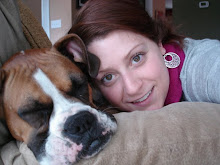Let me preface this by saying that while I'd rank this about a 4 on a scale of 1-10 for difficulty, this project is not for the faint of heart. What it requires is a time investment (think 1 week, minimum) as well as a great deal of patience and attention to detail.
However, if you are tired of your ho hum builder grade cabinets...this is the perfect way to customize them for an upscale look. You may remember that I had already repainted and
tiled the backsplash, so this was the final step in the transformation!
Here's what you'll need:
- Paint and primer (more on this to come)
- Nice brushes
- Sandpaper (both fine and medium grit)
- Degreaser or TSP
- Painter's Tape
Like any good home improvement project, it starts with agonizing over choices. In our case, I knew I wanted to paint the cabinets white, but who knew there were about 100 million shades of white? After taking a few samples home, I decided on Benjamin Moore's White Dove (not to be confused with Dove White).

Now normally I'd take my swatch down to Home Depot or Lowes and get a color match, but this is not a job for ordinary paint. Think about the banging, food slinging, moisture, and heat that your cabinets are subjected to. As a highly visible and frequently abused kitchen element, you definitely want these babies to come out smooth and durable. After much research and speaking with several paint experts, I decided to go with a new product by Benjamin Moore, "Advance" in a satin finish.

I did come across stories of good results with BM's Satin Impervo (both oil and waterborne) as well as Aura. There are also several specialty paints made for cabinets, but they are not always easy to find. After a recommendation from their staff, I decided to give this oil/water hybrid product from BM a shot. I purchased some nice brushes, a gallon of their Fresh Start All Purpose Primer and was on my way.
Once you gather all your supplies, the next step is to take down all your cabinet doors and drawer fronts and remove all hardware/hinges. If your kitchen has a complicated layout, you may want to label what came from where to make the re-install less of a headache. Otherwise, get out your cleaning and sanding supplies.
You might be tempted to rush into painting, but let me warn you that your finished product depends entirely on this prep work. Clean your cabinet boxes and doors thoroughly and give them a good roughing up with some medium grit sandpaper/block. My cabinets had a glossy veneer which I didn't sand completely through-I just sanded enough to take the sheen off and give the surface some grip. Be sure to wipe away the dust with a tack cloth or damp lint free cloth.
Once your cabs are clean and stripped (hehe), give them a coat of primer. For the best adhesion, let the primer cure for a full 24 hours. Patience is a virtue, my friends. The following day prime the back side of the cabinets. To save some time, I actually painted a first finish coat on my boxes the same day. Are you starting to see the pattern here? It's a whole lot of painting and a whole lot of waiting. Once the back side primer is dry, turn the doors over and give them a light sand with some fine grit sandpaper.
If this is all getting a bit confusing, let me lay out the order like this.
Day 1- Clean, sand, prime boxes and front of doors
Day 2- Lightly sand boxes and put on a first finish coat, prime back of doors
Day 3- Lightly sand front of doors and put on a first finish coat. Lightly sand first coat on boxes and paint a second (and final) finish coat.
Day 4- Lightly sand back of doors and put on a first finish coat.
Day 5- Lightly sand first coat on front of doors and put on a second coat.
Day 8 or 9 or if you have a ton of time Day 10- Reattach hardware and re-hang doors!
Before you get started, let me detail the painting technique I was shown at Benjamin Moore specifically for the Advance paint. It's designed to flow like oil, so you don't want to overwork it. Put a good amount on your brush and use long strokes to spread it as evenly as possible. Let it settle itself, try not to go back and brush it too much because it will start to set up in a few minutes. The good news is that you effectively have one practice coat to see how the paint feels and flows. By the second coat, you should be a pro!
Despite all the work, the result is totally worth it. First, let's look at those boring they-fell-off-the-contractor's-truck boxes.

After a brief stint as a disaster area...

The kitchen came together beautifully (if I do say so myself).



I also added some beadboard paneling in certain areas, which I'll show you how to do in another post this week. So, what's the verdict? You likey? Anyone else thinking about attempting this?
*******Shared On The Following Blogs********


















